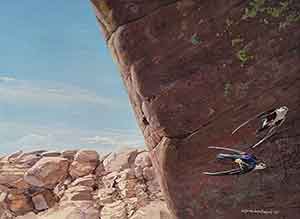Copulation |
|
|---|---|

painting of White-throated Swifts by Carel Brest van Kempen |
Unlike the testes of mammals, those of birds vary greatly in size with the seasons. During the breeding season they may be several hundred times larger than they are during the rest of the year and can account for as much as a tenth of the male's body weight. The massive enlargement of the testes is triggered in temperate-zone birds by day length (curiously enough not timed by the amount of light received by the eyes, but by light passing through the skull and stimulating photoreceptors on the brain). As the days lengthen in the spring, increases in hormones produced by the brain initiate the enlargement of the testes. This stimulus occurs weeks in advance of the actual breeding season, so that the male arrives on the breeding grounds with the testes fully developed. A similar sequence results in the enlargement of the female reproductive organs, development of eggs in the ovaries, formation of the brood patch, and so on. |
|
Enlarged testes secrete
greater amounts of male hormones that may brighten skin (not
feather) colors and stimulate singing and courtship
behavior. During copulation, the male mounts the female from
behind. Both sexes hold their tails to the side and turn
back the feathers around the cloaca (the common opening of
the bird's alimentary canal and excretory and reproductive
systems), so that the swollen lips of the male's and
female's cloacae can come into contact. In some birds, such
as geese, ducks, and game birds, there is a grooved,
erectile penis inside the male's cloaca. The penis guides
the sperm, which have been stored in a nearby sac, into the
female. In passerines, there is no penis, and copulation
amounts to a brief "cloacal kiss" during which the sperm are
transferred. Once transferred, the sperm remain for a while in storage at the lower end of the oviduct, and then swim to the upper end of that duct to fertilize the egg. A single copulation is usually sufficient to fertilize the eggs laid over a period of about a week. In some birds the sperm remain viable for much longer -- turkeys have been reported to lay fertile eggs more than two months after copulation. Consequently, there is considerable variation among species in the frequency of copulations. If copulation is observed in the field, the habitat, time of day, position used, duration, and any associated behavior should be recorded. In most terrestrial species, copulation takes place either on the ground, on a tree limb, or on some other perch. Some aquatic birds (phalaropes, ducks) copulate primarily in the water. Among the most spectacular sights North American bird enthusiasts can see is a mating flight of White-throated Swifts. A group may come swooping down a canyon at high speed, shortly after dawn, with pairs tumbling together as they copulate in midair. Goshawks may copulate as many as 500 to 600 times per clutch of eggs, while the Eurasian Skylark (which has been introduced onto Vancouver Island) copulates but once. The reason for the difference appears to be related to the chances that other males will manage to copulate with the female in a "monogamous" pair. In birds of prey and many colonial species, males must spend long periods away from females and therefore cannot guard their mates from other males. It is in those species that multiple matings seem to occur, as the male attempts to dilute any other male's semen that the female may have acquired in his absence. |
|
| SEE:
Monogamy;
Breeding Season;
Brood Patches;
Courtship Feeding. Copyright ® 1988 by Paul R. Ehrlich, David S. Dobkin, and Darryl Wheye. |
|